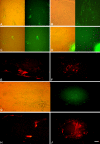Neural induction from ES cells portrays default commitment but instructive maturation
- PMID: 18092007
- PMCID: PMC2121127
- DOI: 10.1371/journal.pone.0001349
Neural induction from ES cells portrays default commitment but instructive maturation
Abstract
The neural induction has remained a debatable issue pertaining to whether it is a mere default process or it involves precise instructive cues. We have chosen the embryonic stem (ES) cell model to address this issue. In a devised monoculture strategy, the cell-cell interaction availed through optimum cell plating density could define the niche for the attainment of efficient in vitro neurogenesis from the ES cells. The medium plating density was found ideal in generating optimum number of progenitors and also yielded about 80% mature neurons in a serum free culture set up barring any exogenous inducers. We could also demarcate and quantify the neural stem cells/progenitors among the heterogeneous cell population of differentiating ES cells using nestin intron II driven EGFP expression as a tool. The one week post-plating was determined to be the critical time window for optimum neural progenitor generation from ES cells that helped us further in purifying these cells and in demonstrating their proliferation and multipotent differentiation potential. Seeding cells at varying densities, we could decipher an interesting paradoxical scenario that interlinked both commitment and maturation with the initial plating density having a vital influence on neuronal maturation but not specification and the secretory factors were apparently playing a key role during this process. Thus it was comprehended that, the neural specification was a default process independent of exogenous factors and cellular interaction. Conversely, a defined number of cells at the specification stage itself seemed critical to provide an auto-/paracrine means of signaling threshold for the maturation process to materialize.
Conflict of interest statement
Figures










References
-
- Hemmati-Brivanlou A, Melton D. Vertebrate embryonic cells will become nerve cells unless told otherwise. Cell. 1997;88:13–17. - PubMed
-
- Munoz-Sanjuan I, Hemmati-Brivanlou A. Neural induction, the default model and embryonic stem cells. Nat Rev Neurosci. 2002;3:271–280. - PubMed
-
- Ying QL, Stavridis M, Griffiths D, Li M, Smith A. Conversion of embryonic stem cells into neuroectodermal precursors in adherent monoculture. Nat Biotechnol. 2003a;21:183–186. - PubMed
-
- Tropepe V, Hitoshi S, Sirard C, Mak TW, Rossant J, et al. Direct neural fate specification from embryonic stem cells: a primitive mammalian neural stem cell stage acquired through a default mechanism. Neuron. 2001;30:65–78. - PubMed
Publication types
MeSH terms
Substances
LinkOut - more resources
Full Text Sources

